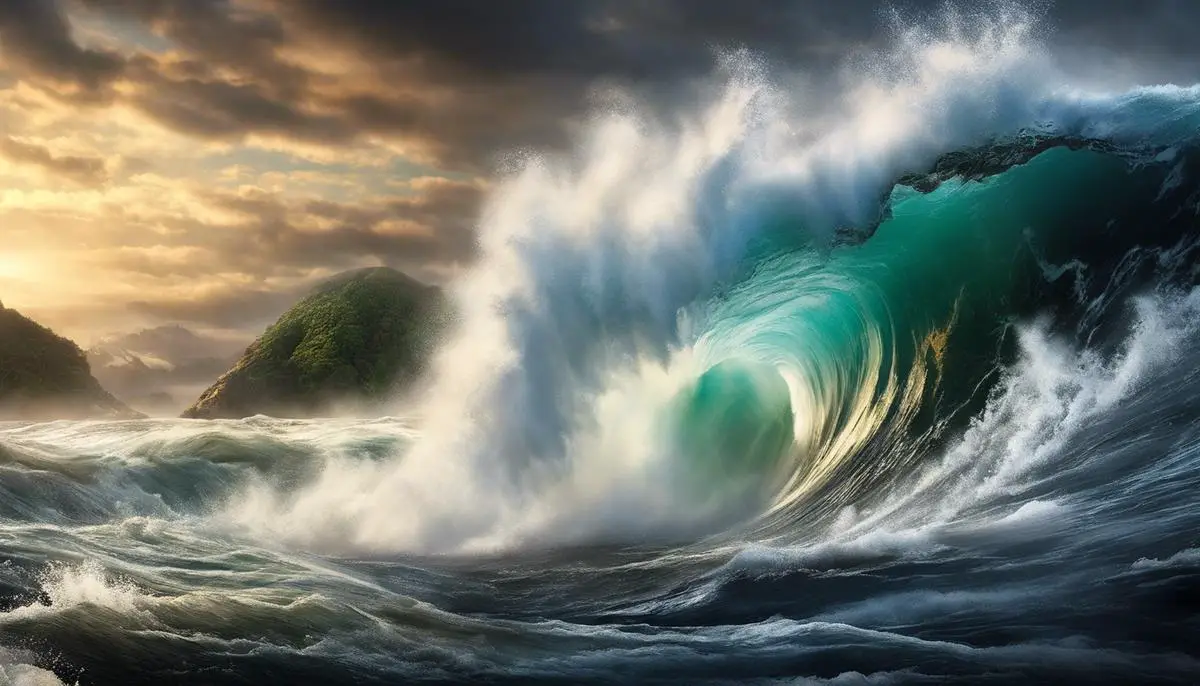Unlocking the secrets of the unconscious mind is a journey that ventures into the mysterious realm of dreams, where symbolic imagery offers glimpses into our deepest emotions and desires. Among these symbols, the representation of an ‘Emotional Flood’ serves as a powerful depiction of the surging emotional landscape within us. This exploration speaks volumes about our hidden inner turmoil and unexpressed feelings. The narratives spun by Sigmund Freud and Carl Jung provide a framework to delve into this complex symbol, thereby helping us decode the messages our subconscious mind strives to communicate. With a thorough understanding of various psychological theories and an analysis of real-life occurrences, we strive to comprehend the profound concept of an emotional flood as a dream symbol.
Understanding Dream Symbols
At the juncture between the realms of neuroscience, psychology, and anthropological studies, lies a fascinating and intriguing field that continuously motivates the scientific investigation – dream analysis. This compelling but largely unexplored domain possesses vast unchartered territories that promise insights into the most profound recesses of the human psyche. An intriguing area within dream research involves the decoding of dream symbols – a tool that could potentially enhance our understanding and analysis of dreams.
Dream symbols, inherent to our subconscious landscapes, are integral to the decoding process. They encompass an array of elements that impregnate our dreams, from the commonplace – such as houses and cars – to the more obscure – like flying or being chased. For centuries, these symbols have been treated as a storytelling language, conveying profound personal and universal truths coded in their mysterious semiotics.
With the evolution of neuroscientific methodologies, new possibilities arise in terms of understanding these codes. If the brain, as we understand it, engages in metaphorical thinking and symbolic representation, then dreams, as the output of the brain function, could presumably follow the same conceptual path.
Psychologically, Sigmund Freud, the father of psychoanalysis, propagated the theory that these images or symbols could represent repressed desires and unconscious thoughts. Each symbol in a dream may characterize different facets of the dreamer’s psyche, thereby unraveling a mental tableau that otherwise remains hidden in the contours of consciousness. For example, a dream involving water might unveil underlying emotional turmoil or perpetually suppressed feelings.
Carl Jung, another prominent psychoanalyst, proffered an eccentric yet insightful perspective. According to Jungian psychology, dream symbols also have collective connotations, derived from our shared cultural heritage and experiences, which he termed as “collective unconscious”. Thus, common symbols shared among people may uphold universal meanings, transcending individual experiences.
In recent years, cognitive science has offered a new perspective on dream symbols. This perspective refers to dreams as a cognitive process involving metaphorical mapping and conceptual blending whereby concepts from different semantic domains are merged to create novel meaning.
Psycholinguistic examinations reveal that dream symbols could possess syntactic and semantic structures, similar to the linguistic constructs of our waking life. Therefore, a comprehensive analysis combining both individualistic (Freudian and Jungian) and collective (cognitive scientific) interpretations could pave the path for a deeper understanding of dream symbolism.
It is clear that dream symbols, complex as they are, offer a labyrinth of neuroscientific and psychological implications. Comprehending them could make dream analysis more enlightening and precise. In the quest for better understanding the human mind, acknowledging the role of dream symbols is a step closer towards unearthing its secrets.
Whether it is mapping the human brain during sleep or doing cognitive therapy for dream intersections, the crux is understanding dream symbols. The path to the in-depth comprehension of our dreams lies in learning this complex language of symbols the mind composes each night as we sleep. Ultimately, the understanding of dream symbols is crucial to the process of dream analysis, an understanding which might just be the key to decipher the complex code of human consciousness.

Emotional Flood as a Dream Symbol
In the fascinating realm of dream analysis, one symbol that recurrently surfaces to captivate our intellectual curiosity is the ’emotional flood.’
This symbol, imbued with rich semantic gradients, can offer profound insights into the psyche of the dreamer when interpreted with insight and acumen.
The ’emotional flood’ in dreams, as the name suggests, serves as a potent metaphor for overwhelming emotions, unresolved issues, or suppressed anxiety that the dreamer might be grappling with. The imagery draws upon water’s inherent characteristics such as its fluidity, formlessness, and unfettered power, encapsulating the dreamer’s emotional state with profound accuracy.
The flood in dreams, usually a dramatic spectacle, is understood to underline the tumultuous nature and intensity of emotional experiences that might baffle the conscious mind but are laid bare in the spotlight of a dream sequence.
Sequentially analyzing the ’emotional flood’ imagery, it’s pertinent to probe whether the dreamer is engulfed in or observing the flood. A dreamer immersed in the flood might reflect submersion in emotional turmoil. On the other hand, viewing the flood from a distance might suggest the individual’s struggle to comprehend their own existence amid chaotic and disruptive scenarios.
Leveraging Carl Jung’s premise of universal archetypes, the flood in dreams may symbolically represent a period of renewal or cleansing. The destructive aspect of the flood transforms into a regenerative force, heralding profound inner changes. It portrays the upheaval often associated with transformative experiences, signaling the sweep of the old to make way for new perspectives.
From a cognitive science viewpoint, the flood imagery could be a creative synthesis of individual lived experiences with a collectively shared metaphoric representation of intense emotions. This symbiotic blend of individualistic and collective interpretations further magnifies the symbol’s complexity and profundity, making it a rich prospect for analysis.
A closer reading of the emotional flood symbol also uncovers its alignment with Freudian perspectives, suggesting it could be a manifestation of repressed desires or fears. For instance, a destructive flood could symbolize uncontrolled emotions or dread corresponding to a particular aspect of the dreamer’s life, threatening to cause metaphorical damage.
In essence, the ’emotional flood’ symbol in dreams stands as a fascinating testament to the intricacies of human emotions and consciousness. It not only provides a peek into individual emotional turmoils, transformations, or aspirations but also bridges the gap between personal experiences and universal archetypes. It reinforces the vital significance of dream analysis in decoding the profound enigma of human minds and emotions, reiterating that understanding dream symbols could be a gateway to acquiring better insight into the complexities of human consciousness.

Psychological Implications of Dreaming of Emotional Flood
Continuing forward in our rigorous exploration of dream symbols, we delve into the psychological dimensions associated with the spectacle of an ’emotional flood’ in dreams. This phenomenon, equally intriguing as it is rich in symbolic nuance, is an encapsulation of a myriad of facets of the human emotional landscape.
Depicting an ’emotional flood’ in dreams is a nuanced and coded message from our subconscious mind, but what does it mean precisely? Diverse cultures and traditions around the globe perceive water – specifically large bodies like oceans, seas, or floods – as emblematic of the deepest human emotions, ranging from fear to love, happiness to anger, or anxiety to calmness. The principle of an ’emotional flood’ might present itself when an individual is experiencing an overwhelming rush of emotions, thoughts, or feelings that they struggle to process, understand, or delineate, spilling over their emotional barriers.
In the analytical view in the vein of Carl Jung, a dream showcasing an ’emotional flood’ can be traced to explorations of the collective unconscious and archetypes. The flood, as a universal archetype, can stand in as a metaphor for a deluge of emotions or unconscious material briskly rising to the conscious mind. It portrays a transformative process where the known territory (consciousness) is deluged by the waters of the unconscious, further hinting a call for integration and acknowledgment of these disregarded facets of the self.
From a cognitive scientific perspective, dreaming of an ’emotional flood’ shows an intricate conceptual blending, revealing a complex interweaving of emotions, thoughts, and physical sensations. The metaphorical flood may symbolize a collective understanding that emotions, like water, are fluid, powerful, and can be overwhelming when not properly channeled.
On the Freudian front, dreaming of an ’emotional flood’ can indicate repressed desires or fears surfacing from the unconscious recesses of the mind. A flood, often associated with destruction and cleansing, may serve as a symbol of a cathartic emotional release of these repressed experiences, leading to potential renewal.
Analyzing the concept of an ’emotional flood’ in dreams through different theoretical lenses serves to illuminate its complexity and profundity. Its presence in the dream landscape contributes to the body of evidence underscoring the significance of dream analysis in unraveling the intricacies of human emotion and consciousness.
Interpreting this emotional inundation can enable us to fathom the deepest recesses of our psyche, contributing to self-realization and emotional understanding. Whether seen as a process of emotional overflow, a symbol of repressed desires, or a metaphor for transformative self-integration, the ’emotional flood’ surely becomes a beacon of insight in illuminating the human emotional experience nested within our nighttime reveries. Thus, the study of such dream symbols serves to underscore the depth and breadth of human consciousness, enriching our understanding of the psyche in its most profound corners.

Case Studies on Emotional Flood Dreams
Unveiling the Emotional Deluge: Investigating ‘Emotional Flood’ Dreams through Case Studies
Undeniably, water’s diverse forms and tumultuous nature in dreams embody a striking indication of our emotional state. This article will further delve into the archetype, specifically, the ‘emotional flood’ dream. Real case studies serve as illuminating torches in the labyrinth of dream analysis, shedding light on the elusive yet profound characterization of these dreams.
Diving Into The Deep End: Case Studies and Emotional Flood Dreams
Case studies function as microscopes, allowing a closer inspection of the intricate nature of the emotional flood dream phenomenon. Each analyzed situation unravels strands of perceptions, emotions, experiences, and associations intertwined with the ’emotional flood’ symbol. For instance, a case study involving an individual experiencing a sequence of ‘emotional flood’ dreams at the time of a family member’s illness can evoke an understanding of the archetype as a representation of overwhelming feelings of fear, anxiety, or helplessness.
The Blitzkrieg of Emotions: Swimming Against the Tide
Conversely, another case study, where the dreamer was grappling with substantial life changes like professional transition or relocating, may interpret the flood symbol quite differently. The flood here may symbolize an immense surge of feelings associated with adaptability and acceptance. Therefore, through the case study lens, these dreams might offer an impression of the psychological disarray that individuals often experience during transitional life phases.
Unearthing Archetypical Undercurrents: The Collective Unconscious
Interpreting from Jung’s viewpoint, case studies of ‘emotional flood’ dreams often reveal a common ground that aligns with his theory of collective unconscious. The flood, a universal symbol not exclusive to any specific culture or geography, suggests shared human experiences and emotions. Hence, by examining numerous case studies across different demographics, one can discern a collective emotional undercurrent, thereby attesting to Jung’s postulations.
Neurons And Narratives: The Cognitive Angle
Additionally, cognitive science provides an integral perspective to the discussion. It proposes that dreams, including those imbued with the ’emotional flood,’ do not merely reflect emotional discourse but participate in its construction and modulation. Therefore, the case study analysis extends beyond merely linking the flood symbol with specific emotional semantics but recognizes its influential role in shaping the dreamer’s affective life.
The Subconscious Sea: Surfacing Repressed Emotions
Drawing from Freud’s pool of wisdom, case studies strengthen our comprehension of repressed emotions and unconscious complexities. ‘Emotional flood’ dreams might be unveiling forbidden desires, latent fears, or unresolved issues, surfacing initially as visually potent floods. An exploration of case studies, particularly those involving individuals undergoing psychotherapy, might unearth these hidden mental realms.
In essence, analyzing authentic case studies provides invaluable insights into ’emotional flood’ dreams. Each discovered layer peels back to reveal a profound understanding of human emotions, consciousness, and inherent complexities. This interpretive journey empowers the individual, encouraging self-realization and attaining a more profound understanding of their emotional ecosystem. In plunging the depths of these emotional floods, we surface, not only with a gasp of air, but with a treasure chest of intrapersonal knowledge.

By navigating the torrent of emotions encapsulated within the dream symbol of an ‘Emotional Flood’, we are offered an opportunity to gain a profound understanding of our own psyche. The potency of this symbol, rich in psychological implications, uncovers the deep-seated emotions and introspections that influence our waking lives. Supplementing theories with real-life instances further validates the relationship between dreams and the unconscious mind, driving home the essential role of dream symbols in facilitating self-understanding and emotional release. Thus, diving deep into the ebb and flow of our emotional reservoirs through these symbols is a profound journey towards self-discovery and personal growth.
